lock Abarth 124 Spider 2021 Owner handbook (in English)
[x] Cancel search | Manufacturer: ABARTH, Model Year: 2021, Model line: 124 Spider, Model: Abarth 124 Spider 2021Pages: 224, PDF Size: 3.9 MB
Page 22 of 224
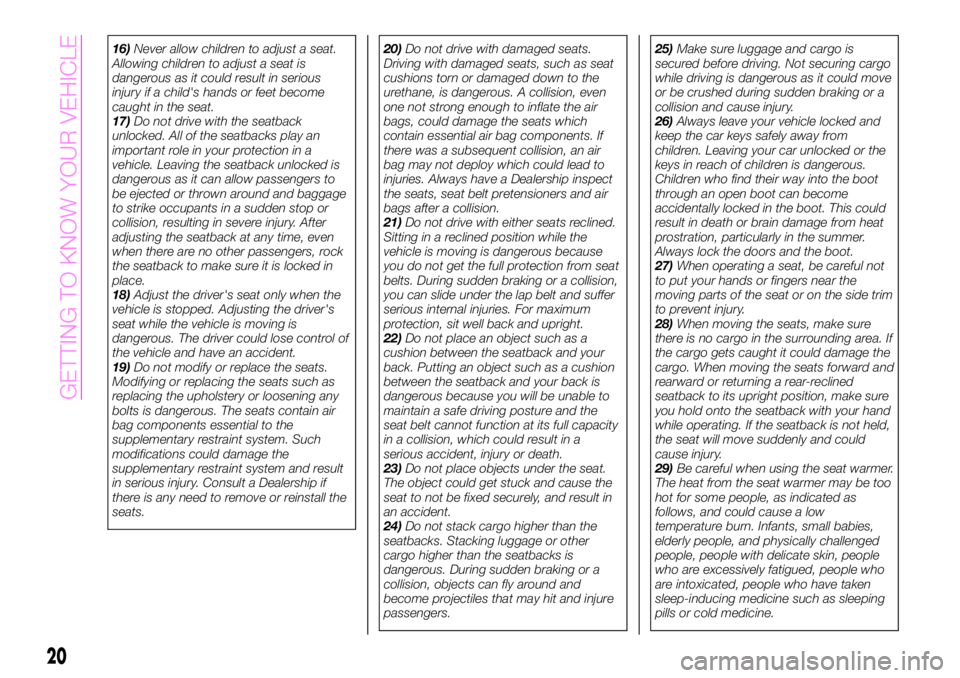
16)Never allow children to adjust a seat.
Allowing children to adjust a seat is
dangerous as it could result in serious
injury if a child's hands or feet become
caught in the seat.
17)Do not drive with the seatback
unlocked. All of the seatbacks play an
important role in your protection in a
vehicle. Leaving the seatback unlocked is
dangerous as it can allow passengers to
be ejected or thrown around and baggage
to strike occupants in a sudden stop or
collision, resulting in severe injury. After
adjusting the seatback at any time, even
when there are no other passengers, rock
the seatback to make sure it is locked in
place.
18)Adjust the driver's seat only when the
vehicle is stopped. Adjusting the driver's
seat while the vehicle is moving is
dangerous. The driver could lose control of
the vehicle and have an accident.
19)Do not modify or replace the seats.
Modifying or replacing the seats such as
replacing the upholstery or loosening any
bolts is dangerous. The seats contain air
bag components essential to the
supplementary restraint system. Such
modifications could damage the
supplementary restraint system and result
in serious injury. Consult a Dealership if
there is any need to remove or reinstall the
seats.20)Do not drive with damaged seats.
Driving with damaged seats, such as seat
cushions torn or damaged down to the
urethane, is dangerous. A collision, even
one not strong enough to inflate the air
bags, could damage the seats which
contain essential air bag components. If
there was a subsequent collision, an air
bag may not deploy which could lead to
injuries. Always have a Dealership inspect
the seats, seat belt pretensioners and air
bags after a collision.
21)Do not drive with either seats reclined.
Sitting in a reclined position while the
vehicle is moving is dangerous because
you do not get the full protection from seat
belts. During sudden braking or a collision,
you can slide under the lap belt and suffer
serious internal injuries. For maximum
protection, sit well back and upright.
22)Do not place an object such as a
cushion between the seatback and your
back. Putting an object such as a cushion
between the seatback and your back is
dangerous because you will be unable to
maintain a safe driving posture and the
seat belt cannot function at its full capacity
in a collision, which could result in a
serious accident, injury or death.
23)Do not place objects under the seat.
The object could get stuck and cause the
seat to not be fixed securely, and result in
an accident.
24)Do not stack cargo higher than the
seatbacks. Stacking luggage or other
cargo higher than the seatbacks is
dangerous. During sudden braking or a
collision, objects can fly around and
become projectiles that may hit and injure
passengers.25)Make sure luggage and cargo is
secured before driving. Not securing cargo
while driving is dangerous as it could move
or be crushed during sudden braking or a
collision and cause injury.
26)Always leave your vehicle locked and
keep the car keys safely away from
children. Leaving your car unlocked or the
keys in reach of children is dangerous.
Children who find their way into the boot
through an open boot can become
accidentally locked in the boot. This could
result in death or brain damage from heat
prostration, particularly in the summer.
Always lock the doors and the boot.
27)When operating a seat, be careful not
to put your hands or fingers near the
moving parts of the seat or on the side trim
to prevent injury.
28)When moving the seats, make sure
there is no cargo in the surrounding area. If
the cargo gets caught it could damage the
cargo. When moving the seats forward and
rearward or returning a rear-reclined
seatback to its upright position, make sure
you hold onto the seatback with your hand
while operating. If the seatback is not held,
the seat will move suddenly and could
cause injury.
29)Be careful when using the seat warmer.
The heat from the seat warmer may be too
hot for some people, as indicated as
follows, and could cause a low
temperature burn. Infants, small babies,
elderly people, and physically challenged
people, people with delicate skin, people
who are excessively fatigued, people who
are intoxicated, people who have taken
sleep-inducing medicine such as sleeping
pills or cold medicine.
20
GETTING TO KNOW YOUR VEHICLE
Page 23 of 224
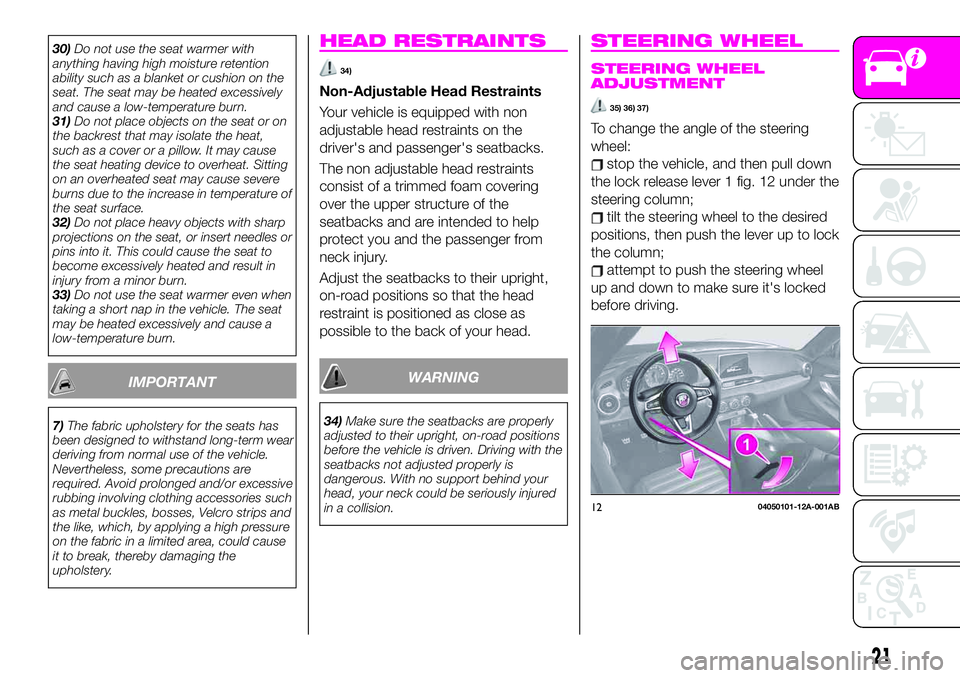
30)Do not use the seat warmer with
anything having high moisture retention
ability such as a blanket or cushion on the
seat. The seat may be heated excessively
and cause a low-temperature burn.
31)Do not place objects on the seat or on
the backrest that may isolate the heat,
such as a cover or a pillow. It may cause
the seat heating device to overheat. Sitting
on an overheated seat may cause severe
burns due to the increase in temperature of
the seat surface.
32)Do not place heavy objects with sharp
projections on the seat, or insert needles or
pins into it. This could cause the seat to
become excessively heated and result in
injury from a minor burn.
33)Do not use the seat warmer even when
taking a short nap in the vehicle. The seat
may be heated excessively and cause a
low-temperature burn.
IMPORTANT
7)The fabric upholstery for the seats has
been designed to withstand long-term wear
deriving from normal use of the vehicle.
Nevertheless, some precautions are
required. Avoid prolonged and/or excessive
rubbing involving clothing accessories such
as metal buckles, bosses, Velcro strips and
the like, which, by applying a high pressure
on the fabric in a limited area, could cause
it to break, thereby damaging the
upholstery.
HEAD RESTRAINTS
34)
Non-Adjustable Head Restraints
Your vehicle is equipped with non
adjustable head restraints on the
driver's and passenger's seatbacks.
The non adjustable head restraints
consist of a trimmed foam covering
over the upper structure of the
seatbacks and are intended to help
protect you and the passenger from
neck injury.
Adjust the seatbacks to their upright,
on-road positions so that the head
restraint is positioned as close as
possible to the back of your head.
WARNING
34)Make sure the seatbacks are properly
adjusted to their upright, on-road positions
before the vehicle is driven. Driving with the
seatbacks not adjusted properly is
dangerous. With no support behind your
head, your neck could be seriously injured
in a collision.
STEERING WHEEL
STEERING WHEEL
ADJUSTMENT
35) 36) 37)
To change the angle of the steering
wheel:
stop the vehicle, and then pull down
the lock release lever 1 fig. 12 under the
steering column;
tilt the steering wheel to the desired
positions, then push the lever up to lock
the column;
attempt to push the steering wheel
up and down to make sure it's locked
before driving.
1204050101-12A-001AB
21
Page 24 of 224
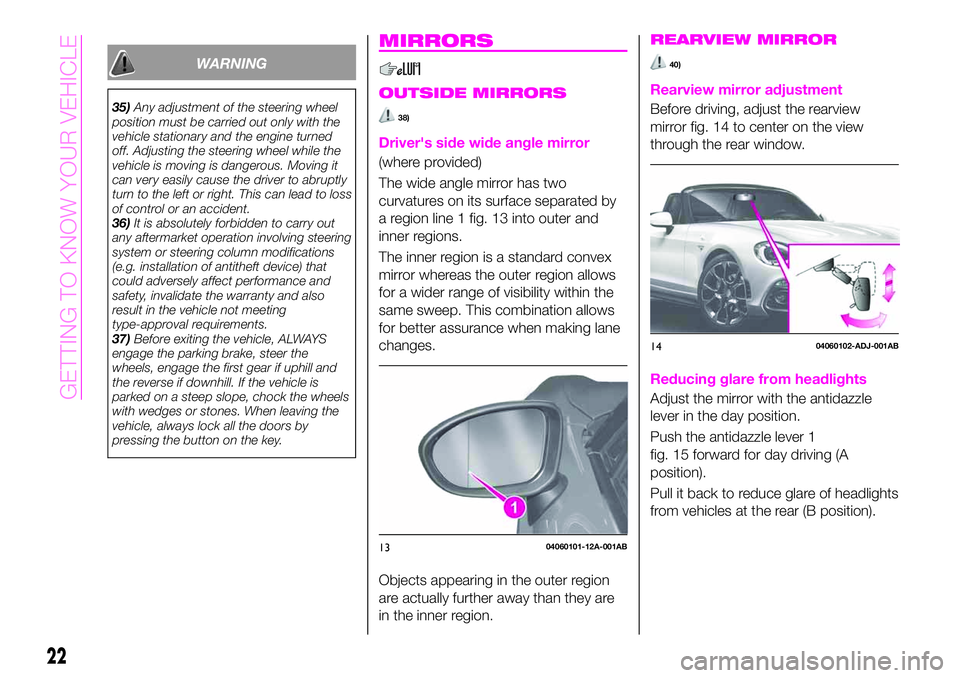
WARNING
35)Any adjustment of the steering wheel
position must be carried out only with the
vehicle stationary and the engine turned
off. Adjusting the steering wheel while the
vehicle is moving is dangerous. Moving it
can very easily cause the driver to abruptly
turn to the left or right. This can lead to loss
of control or an accident.
36)It is absolutely forbidden to carry out
any aftermarket operation involving steering
system or steering column modifications
(e.g. installation of antitheft device) that
could adversely affect performance and
safety, invalidate the warranty and also
result in the vehicle not meeting
type-approval requirements.
37)Before exiting the vehicle, ALWAYS
engage the parking brake, steer the
wheels, engage the first gear if uphill and
the reverse if downhill. If the vehicle is
parked on a steep slope, chock the wheels
with wedges or stones. When leaving the
vehicle, always lock all the doors by
pressing the button on the key.
MIRRORS
OUTSIDE MIRRORS
38)
Driver's side wide angle mirror
(where provided)
The wide angle mirror has two
curvatures on its surface separated by
a region line 1 fig. 13 into outer and
inner regions.
The inner region is a standard convex
mirror whereas the outer region allows
for a wider range of visibility within the
same sweep. This combination allows
for better assurance when making lane
changes.
Objects appearing in the outer region
are actually further away than they are
in the inner region.
REARVIEW MIRROR
40)
Rearview mirror adjustment
Before driving, adjust the rearview
mirror fig. 14 to center on the view
through the rear window.
Reducing glare from headlights
Adjust the mirror with the antidazzle
lever in the day position.
Push the antidazzle lever 1
fig. 15 forward for day driving (A
position).
Pull it back to reduce glare of headlights
from vehicles at the rear (B position).
1304060101-12A-001AB
1404060102-ADJ-001AB
22
GETTING TO KNOW YOUR VEHICLE
Page 25 of 224
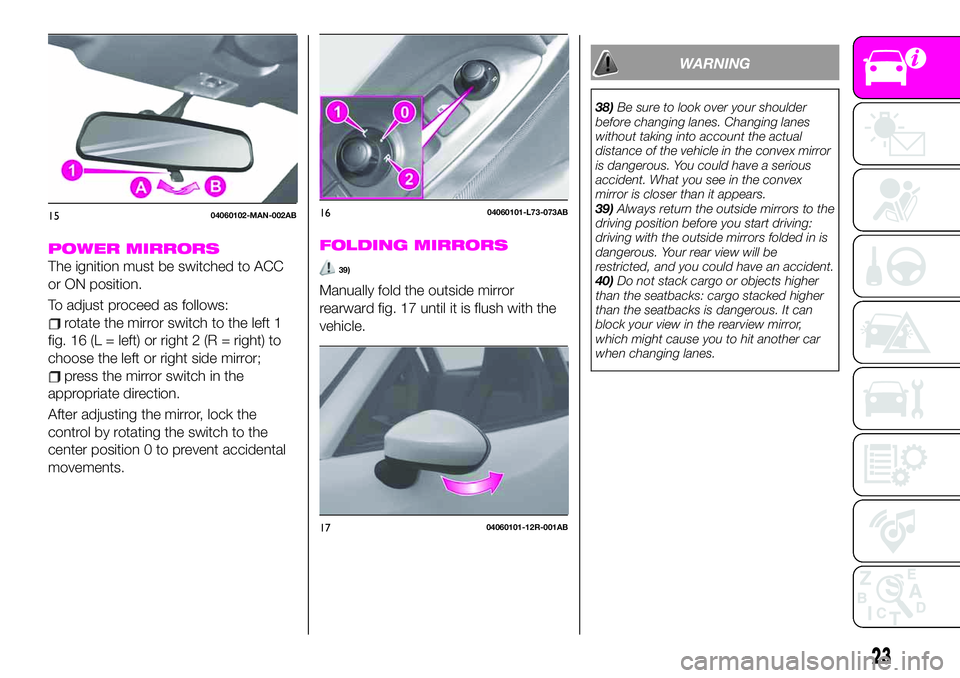
POWER MIRRORS
The ignition must be switched to ACC
or ON position.
To adjust proceed as follows:
rotate the mirror switch to the left 1
fig. 16 (L = left) or right 2 (R = right) to
choose the left or right side mirror;
press the mirror switch in the
appropriate direction.
After adjusting the mirror, lock the
control by rotating the switch to the
center position 0 to prevent accidental
movements.
FOLDING MIRRORS
39)
Manually fold the outside mirror
rearward fig. 17 until it is flush with the
vehicle.
WARNING
38)Be sure to look over your shoulder
before changing lanes. Changing lanes
without taking into account the actual
distance of the vehicle in the convex mirror
is dangerous. You could have a serious
accident. What you see in the convex
mirror is closer than it appears.
39)Always return the outside mirrors to the
driving position before you start driving:
driving with the outside mirrors folded in is
dangerous. Your rear view will be
restricted, and you could have an accident.
40)Do not stack cargo or objects higher
than the seatbacks: cargo stacked higher
than the seatbacks is dangerous. It can
block your view in the rearview mirror,
which might cause you to hit another car
when changing lanes.
1504060102-MAN-002AB1604060101-L73-073AB
1704060101-12R-001AB
23
Page 29 of 224
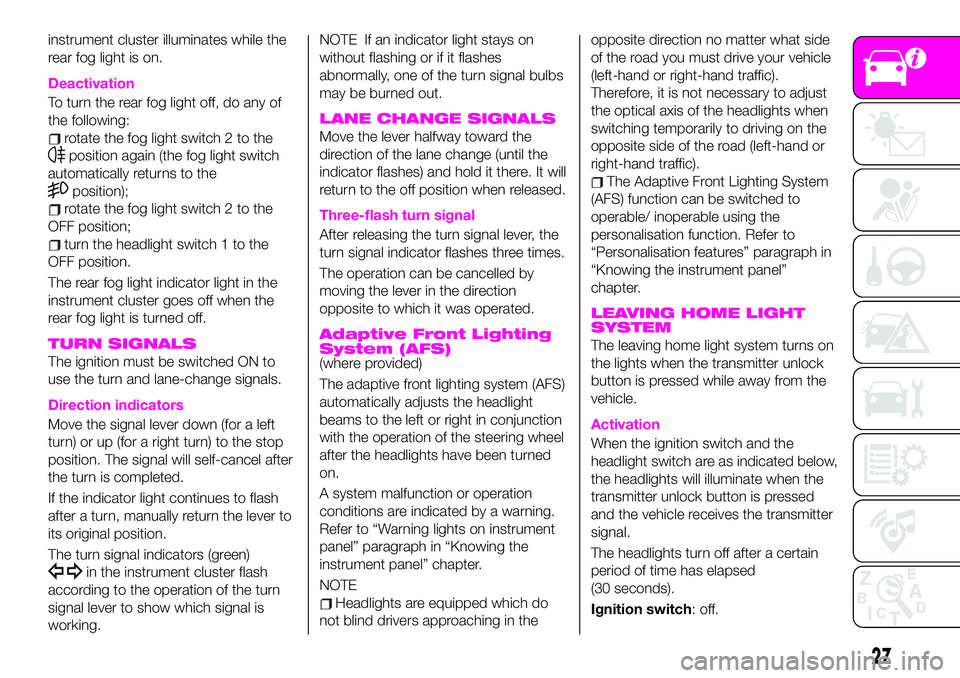
instrument cluster illuminates while the
rear fog light is on.
Deactivation
To turn the rear fog light off, do any of
the following:
rotate the fog light switch 2 to the
position again (the fog light switch
automatically returns to the
position);
rotate the fog light switch 2 to the
OFF position;
turn the headlight switch 1 to the
OFF position.
The rear fog light indicator light in the
instrument cluster goes off when the
rear fog light is turned off.
TURN SIGNALS
The ignition must be switched ON to
use the turn and lane-change signals.
Direction indicators
Move the signal lever down (for a left
turn) or up (for a right turn) to the stop
position. The signal will self-cancel after
the turn is completed.
If the indicator light continues to flash
after a turn, manually return the lever to
its original position.
The turn signal indicators (green)
in the instrument cluster flash
according to the operation of the turn
signal lever to show which signal is
working.
NOTE If an indicator light stays on
without flashing or if it flashes
abnormally, one of the turn signal bulbs
may be burned out.
LANE CHANGE SIGNALS
Move the lever halfway toward the
direction of the lane change (until the
indicator flashes) and hold it there. It will
return to the off position when released.
Three-flash turn signal
After releasing the turn signal lever, the
turn signal indicator flashes three times.
The operation can be cancelled by
moving the lever in the direction
opposite to which it was operated.
Adaptive Front Lighting
System (AFS)
(where provided)
The adaptive front lighting system (AFS)
automatically adjusts the headlight
beams to the left or right in conjunction
with the operation of the steering wheel
after the headlights have been turned
on.
A system malfunction or operation
conditions are indicated by a warning.
Refer to “Warning lights on instrument
panel” paragraph in “Knowing the
instrument panel” chapter.
NOTE
Headlights are equipped which do
not blind drivers approaching in theopposite direction no matter what side
of the road you must drive your vehicle
(left-hand or right-hand traffic).
Therefore, it is not necessary to adjust
the optical axis of the headlights when
switching temporarily to driving on the
opposite side of the road (left-hand or
right-hand traffic).
The Adaptive Front Lighting System
(AFS) function can be switched to
operable/ inoperable using the
personalisation function. Refer to
“Personalisation features” paragraph in
“Knowing the instrument panel”
chapter.
LEAVING HOME LIGHT
SYSTEM
The leaving home light system turns on
the lights when the transmitter unlock
button is pressed while away from the
vehicle.
Activation
When the ignition switch and the
headlight switch are as indicated below,
the headlights will illuminate when the
transmitter unlock button is pressed
and the vehicle receives the transmitter
signal.
The headlights turn off after a certain
period of time has elapsed
(30 seconds).
Ignition switch:off.
27
Page 32 of 224
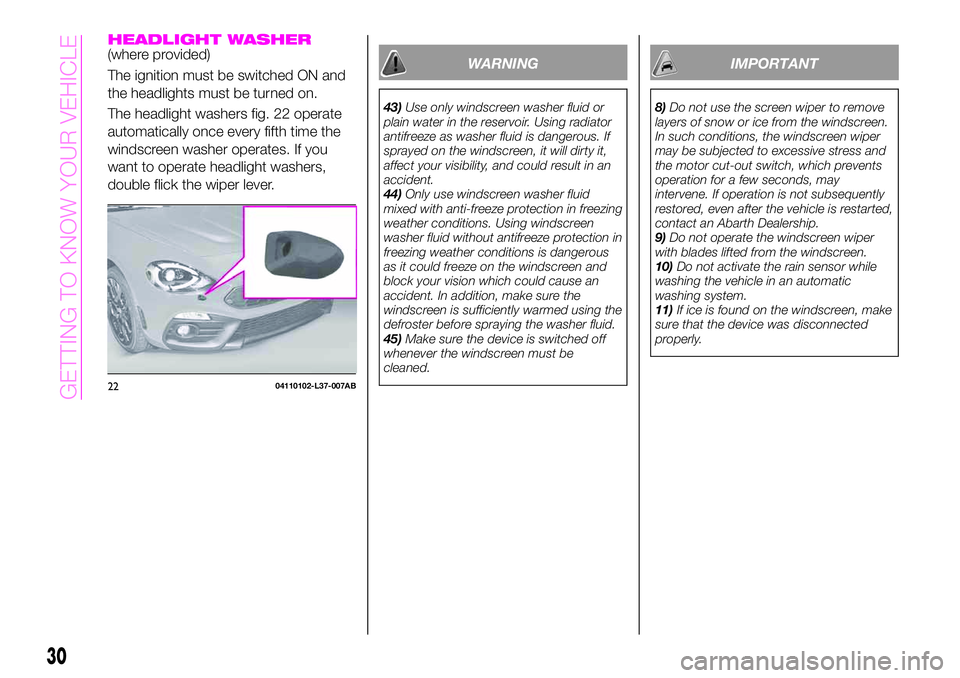
HEADLIGHT WASHER(where provided)
The ignition must be switched ON and
the headlights must be turned on.
The headlight washers fig. 22 operate
automatically once every fifth time the
windscreen washer operates. If you
want to operate headlight washers,
double flick the wiper lever.WARNING
43)Use only windscreen washer fluid or
plain water in the reservoir. Using radiator
antifreeze as washer fluid is dangerous. If
sprayed on the windscreen, it will dirty it,
affect your visibility, and could result in an
accident.
44)Only use windscreen washer fluid
mixed with anti-freeze protection in freezing
weather conditions. Using windscreen
washer fluid without antifreeze protection in
freezing weather conditions is dangerous
as it could freeze on the windscreen and
block your vision which could cause an
accident. In addition, make sure the
windscreen is sufficiently warmed using the
defroster before spraying the washer fluid.
45)Make sure the device is switched off
whenever the windscreen must be
cleaned.
IMPORTANT
8)Do not use the screen wiper to remove
layers of snow or ice from the windscreen.
In such conditions, the windscreen wiper
may be subjected to excessive stress and
the motor cut-out switch, which prevents
operation for a few seconds, may
intervene. If operation is not subsequently
restored, even after the vehicle is restarted,
contact an Abarth Dealership.
9)Do not operate the windscreen wiper
with blades lifted from the windscreen.
10)Do not activate the rain sensor while
washing the vehicle in an automatic
washing system.
11)If ice is found on the windscreen, make
sure that the device was disconnected
properly.
2204110102-L37-007AB
30
GETTING TO KNOW YOUR VEHICLE
Page 35 of 224
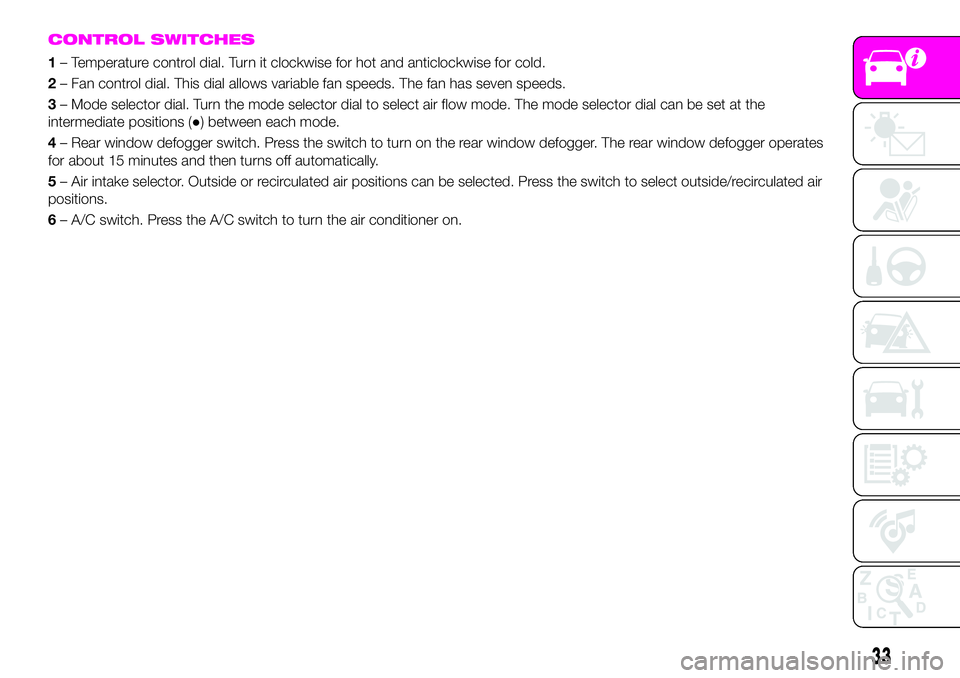
CONTROL SWITCHES
1– Temperature control dial. Turn it clockwise for hot and anticlockwise for cold.
2– Fan control dial. This dial allows variable fan speeds. The fan has seven speeds.
3– Mode selector dial. Turn the mode selector dial to select air flow mode. The mode selector dial can be set at the
intermediate positions (●) between each mode.
4– Rear window defogger switch. Press the switch to turn on the rear window defogger. The rear window defogger operates
for about 15 minutes and then turns off automatically.
5– Air intake selector. Outside or recirculated air positions can be selected. Press the switch to select outside/recirculated air
positions.
6– A/C switch. Press the A/C switch to turn the air conditioner on.
33
Page 38 of 224
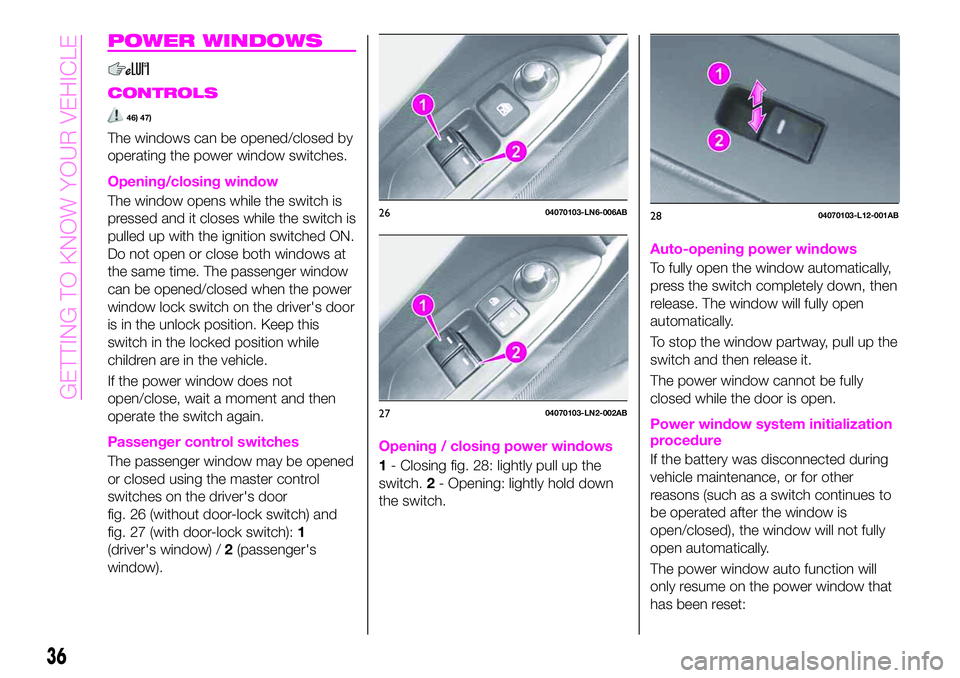
POWER WINDOWS
CONTROLS
46) 47)
The windows can be opened/closed by
operating the power window switches.
Opening/closing window
The window opens while the switch is
pressed and it closes while the switch is
pulled up with the ignition switched ON.
Do not open or close both windows at
the same time. The passenger window
can be opened/closed when the power
window lock switch on the driver's door
is in the unlock position. Keep this
switch in the locked position while
children are in the vehicle.
If the power window does not
open/close, wait a moment and then
operate the switch again.
Passenger control switches
The passenger window may be opened
or closed using the master control
switches on the driver's door
fig. 26 (without door-lock switch) and
fig. 27 (with door-lock switch):1
(driver's window) /2(passenger's
window).Opening / closing power windows
1- Closing fig. 28: lightly pull up the
switch.2- Opening: lightly hold down
the switch.
Auto-opening power windows
To fully open the window automatically,
press the switch completely down, then
release. The window will fully open
automatically.
To stop the window partway, pull up the
switch and then release it.
The power window cannot be fully
closed while the door is open.
Power window system initialization
procedure
If the battery was disconnected during
vehicle maintenance, or for other
reasons (such as a switch continues to
be operated after the window is
open/closed), the window will not fully
open automatically.
The power window auto function will
only resume on the power window that
has been reset:
2604070103-LN6-006AB
2704070103-LN2-002AB
2804070103-L12-001AB
36
GETTING TO KNOW YOUR VEHICLE
Page 39 of 224
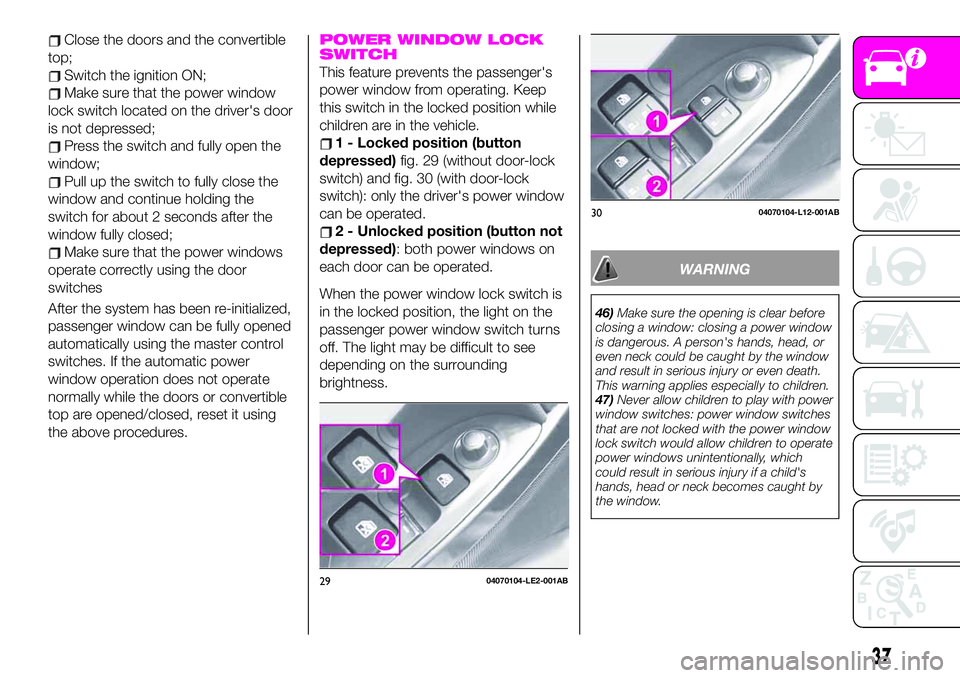
Close the doors and the convertible
top;
Switch the ignition ON;
Make sure that the power window
lock switch located on the driver's door
is not depressed;
Press the switch and fully open the
window;
Pull up the switch to fully close the
window and continue holding the
switch for about 2 seconds after the
window fully closed;
Make sure that the power windows
operate correctly using the door
switches
After the system has been re-initialized,
passenger window can be fully opened
automatically using the master control
switches. If the automatic power
window operation does not operate
normally while the doors or convertible
top are opened/closed, reset it using
the above procedures.
POWER WINDOW LOCK
SWITCH
This feature prevents the passenger's
power window from operating. Keep
this switch in the locked position while
children are in the vehicle.
1 - Locked position (button
depressed)fig. 29 (without door-lock
switch) and fig. 30 (with door-lock
switch): only the driver's power window
can be operated.
2 - Unlocked position (button not
depressed): both power windows on
each door can be operated.
When the power window lock switch is
in the locked position, the light on the
passenger power window switch turns
off. The light may be difficult to see
depending on the surrounding
brightness.
WARNING
46)Make sure the opening is clear before
closing a window: closing a power window
is dangerous. A person's hands, head, or
even neck could be caught by the window
and result in serious injury or even death.
This warning applies especially to children.
47)Never allow children to play with power
window switches: power window switches
that are not locked with the power window
lock switch would allow children to operate
power windows unintentionally, which
could result in serious injury if a child's
hands, head or neck becomes caught by
the window.
2904070104-LE2-001AB
3004070104-L12-001AB
37
Page 41 of 224
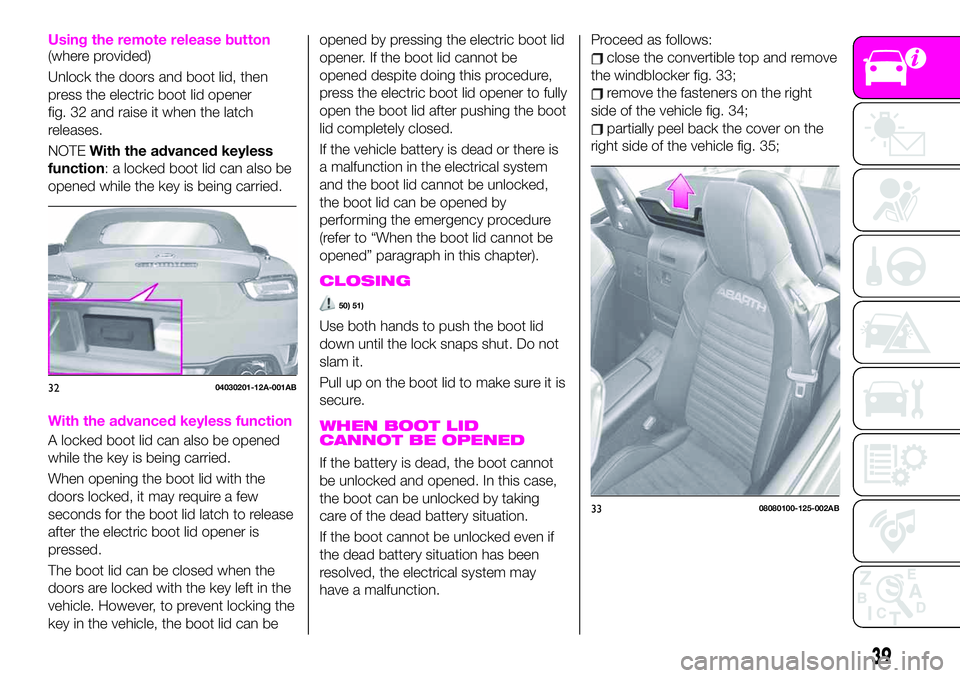
Using the remote release button(where provided)
Unlock the doors and boot lid, then
press the electric boot lid opener
fig. 32 and raise it when the latch
releases.
NOTEWith the advanced keyless
function: a locked boot lid can also be
opened while the key is being carried.
With the advanced keyless function
A locked boot lid can also be opened
while the key is being carried.
When opening the boot lid with the
doors locked, it may require a few
seconds for the boot lid latch to release
after the electric boot lid opener is
pressed.
The boot lid can be closed when the
doors are locked with the key left in the
vehicle. However, to prevent locking the
key in the vehicle, the boot lid can beopened by pressing the electric boot lid
opener. If the boot lid cannot be
opened despite doing this procedure,
press the electric boot lid opener to fully
open the boot lid after pushing the boot
lid completely closed.
If the vehicle battery is dead or there is
a malfunction in the electrical system
and the boot lid cannot be unlocked,
the boot lid can be opened by
performing the emergency procedure
(refer to “When the boot lid cannot be
opened” paragraph in this chapter).
CLOSING
50) 51)
Use both hands to push the boot lid
down until the lock snaps shut. Do not
slam it.
Pull up on the boot lid to make sure it is
secure.
WHEN BOOT LID
CANNOT BE OPENED
If the battery is dead, the boot cannot
be unlocked and opened. In this case,
the boot can be unlocked by taking
care of the dead battery situation.
If the boot cannot be unlocked even if
the dead battery situation has been
resolved, the electrical system may
have a malfunction.Proceed as follows:
close the convertible top and remove
the windblocker fig. 33;
remove the fasteners on the right
side of the vehicle fig. 34;
partially peel back the cover on the
right side of the vehicle fig. 35;
3204030201-12A-001AB
3308080100-125-002AB
39